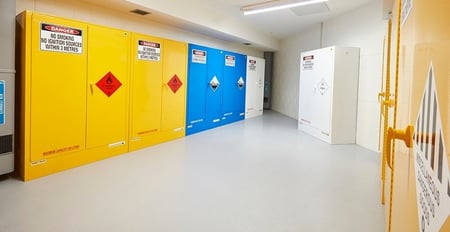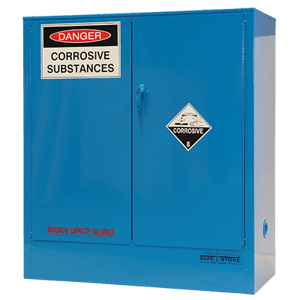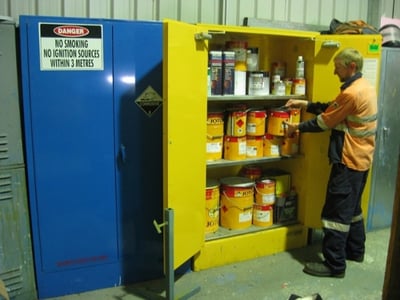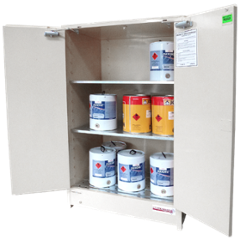Are you sifting through the options for dangerous goods storage? Or perhaps you’ve been told to acquire a chemical cabinet for your workplace — but you’re not quite sure what they are? This post will help you answer the question, ‘What is a chemical cabinet?’. We’ll be explaining how these cabinets reduce risk for organisations. We’ll also be detailing the types of chemicals that you can store in a cabinet, and what types of workplaces can benefit from installing them.
If you’ve been wondering how a chemical cabinet compares with other types of dangerous goods storage options, we’re here to clear up the issue — so you can find out if it’s the right piece of equipment for your operations.
So, What Is It?
Whether you call it a chemical cabinet, HAZMAT storage cabinet or safety cabinet, this type of equipment is one of the most popular types of workplace chemical storage.
Unlike a custom-made chemical store that is constructed within your premises, the indoor chemical cabinet is a ready-made storage solution that is easy to move, install and relocate.
Chemical cabinets are equipped with specific control measures that minimise the likelihood and impact of hazards, such as fire, spillage and harmful vapours.
Cabinets are generally the go-to piece of chemical storage equipment for businesses that are seeking indoor storage for their hazardous chemicals and dangerous goods.
Benefits include:
- Cost-effective – a fully assembled chemical cabinet is a cheaper storage option than a chemical store that is constructed onsite for your premises
- Full range of risk control measures – your ready-made cabinet is already designed and constructed to provide the highest levels of risk control for your chemicals
- Durable – constructed from sheet steel, these cabinets are designed to be a long-term investment for your business, providing protection for years or decades
- Flexible – with fully adjustable shelving within the safety cabinets, you can fit a range of different chemical packages of various dimensions
- Relocatable – if your workspace shifts or changes, your cabinet can be re-installed in a new location with minimum fuss

Chemical cabinets provide a convenient and cost-effective chemical storage option for indoor work areas.
What Type Of Chemicals Do They Store?
Chemical storage cabinets are constructed to house a particular class of dangerous goods. This means that there are chemical cabinets specifically constructed for the storage of dangerous goods, such as:
- Class 3 Flammable Liquids
- Class 4 Flammable Solids
- Class 5.1 Oxidising Agents
- Class 5.2 Organic Peroxides
- Class 6 Toxic Substances
- Class 9 Corrosive Substances
IMPORTANT: If you’re storing dangerous goods such as Class 2.1 Flammables Gases and Class 2.2 Non-Flammable, Non-Toxic Gases, we recommend using gas bottle cages (not safety cabinets) as gases require different risk control features.
You’ll find that the features of each class of cabinet differs to meet the hazard requirements of the particular dangerous goods class that you’re storing.
For example, flammable liquids pose a wide range of risks to the businesses that store them, including the risk of fire or explosion if the vapours meet an ignition source. Therefore, flammable liquids cabinets are designed with self-closing, close-fitting doors (held shut automatically by catches at two or more points), which provide vapour containment, a liquid-tight enclosure and a heat barrier in the event of a workplace fire.
On the other hand, corrosive substances pose the risk of harm to people and property due to their ability to corrode living tissue, metal and other materials. Therefore, a safety cabinet designed for use with corrosive substances will have PVC spill trays on the shelves. This is to prevent chemical attack and damage to the cabinet. This is a unique feature only found in cabinets that house corrosive substances.

Corrosive substance cabinets feature PVC spill trays which protect the cabinet against chemical attack.
We’ll detail some of the general risk control features of a safety cabinet a little later in our blog.
REMEMBER: When storing any type of dangerous goods or hazardous chemicals, you must always be aware of the dangerous goods segregation guidelines. Chemicals may be incompatible or react dangerously with each other, so strict segregation methods must be applied to storage areas.
What’s The Difference Between A Chemical Cabinet and a Chemical Storage Container?
While chemical cabinets are designed for use in an indoor work environment, chemical storage containers are the equivalent solution for outdoor areas. Chemical storage containers are constructed differently to safety cabinets. This is because outdoor containers must provide protection from the elements, such as rain, cyclones and excessive heat. They must also be able to withstand impact from a moving vehicle or falling debris, such as a tree branch that is thrown onto the container during a storm.
While there’s no requirements that prohibit a chemical cabinet from being used outdoors, we strongly recommend that you use chemical cabinets as an indoor dangerous goods storage method.
What Types Of Workplaces Use Chemical Storage Cabinets?
If you’re storing any type of dangerous goods indoors, you could probably consider using a chemical cabinet. From manufacturing plants to hospitality venues and government bodies to schools, there are many industries which rely on these storage cabinets to house their dangerous goods and hazardous substances.

You’re legally obligated to reduce hazards associated with your stores of hazardous chemicals and dangerous goods.
Small businesses, such as painting contractors, can use a smaller safety cabinet to store their paints and thinners. While larger companies may have a variety of chemical cabinets to store a range of dangerous goods classes indoors.
However, the one consideration you may need to make is to check the requirements that relate to the quantities of chemicals that you’re planning to store indoors. There are limits to how much you can store in the indoor environment including restrictions that apply to the aggregate capacity of cabinets in a work area.
An easy way to check this information is by referring to the appropriate Australian Standard. This will provide you with all the requirements that relate to the storage of hazardous chemicals in a safety cabinet.
What Are Some Key Features Of A Chemical Cabinet?
They key reason anyone chooses a chemical cabinet for their workplace is to reduce the risks associated with the chemicals that you have onsite.
Therefore, cabinets offer a range of features (some specific to the dangerous goods class that you’re carrying) to control chemical hazards.
We’ll look at some of the general safety cabinet features below and explain how they can help keep your workplace safe from chemical hazards.
Sheet Steel Construction With Thermic Air Barrier
Safety cabinets must be constructed from a material which is durable and resistant to chemical attack. Therefore, compliant cabinets are built with a double-walled sheet steel construction. They also feature a 40mm thermic air barrier.
This sturdy design provides a multitude of benefits including durability, safety for the stored chemicals, and protection against excessive heat and fire in the work area.
Self-Closing, Tight-Fitting Doors
As we briefly mentioned earlier in this blog, self-closing, tight-fitting doors provide 3 key risk controls for the stored chemicals within the cabinet. These include:
- Heat and fire barrier
- Protection from chemical spills and splashes
- Vapour containment
Along with the sheet steel construction and thermic air barrier features of the cabinet, the doors assist with providing protection against heat and fire. This is of particular importance when you’re storing volatile chemicals such as Class 3 Flammable Liquids.
Chemical packages, such as containers or drums, can create hazards – even while they’re in storage. If packages are split, leaking or they simply topple over, the doors will prevent the chemical from spilling into the work area.
Likewise, any accidental release of chemicals may produce hazardous vapours. This could occur from something as simple as a lid being left off a container or a lid that’s not been securely fastened. The self-closing, tight-fitting doors therefore provide the necessary vapour containment to keep the hazardous vapours within the cabinet.
Perforated Shelving
Following on from our previous point about vapour containment, you want to make sure that air can flow freely in the cabinet to reduce the risk of vapours building up in certain sections of the store.
Perforated shelving allows for the movement of vapours throughout the cabinet, due to the multitude of holes on each steel shelf. This can assist with vapours becoming harmful when staff open the cabinet to retrieve chemical products.

Perforated steel shelving allows hazardous vapours to flow within the cabinet, instead of building up in specific areas of the store.
Liquid-Tight Spill Sump
If you’re working with chemicals, you can probably understand how easy it is for a spill to happen. One of the key requirements of a compliant cabinet is the liquid-tight spill containment sump that is built into the lower area of the cabinet.
Spills are directed into the sump, which can be easily cleaned out whenever there is a spill of leak within the cabinet. This type of bunded storage provides excellent spillage control that will reduce the likelihood and impact of a hazardous spill leaking out into your work area.
Understanding Your Safety Cabinet
Would you like to learn more about chemical safety cabinets? We’ve created a handy guide that will help you select, install, use and maintain your chemical cabinet. Specifically written for businesses that carry flammable liquids, this guide is a helpful tool which can help you reduce hazards in your own workplace. Grab your copy for free now and learn more about indoor dangerous goods storage.
Joining the team as a Dangerous Goods Storage Consultant, Melissa Hampton became Storemasta's Marketing Manager in late 2021. With extensive knowledge and experience in chemical compliance, Melissa is responsible for leading the Marketing team and helping shape their marketing strategy. In her spare time, you can find Melissa hiking, swimming and enjoying the great outdoors in beautiful north-west Tasmania.

